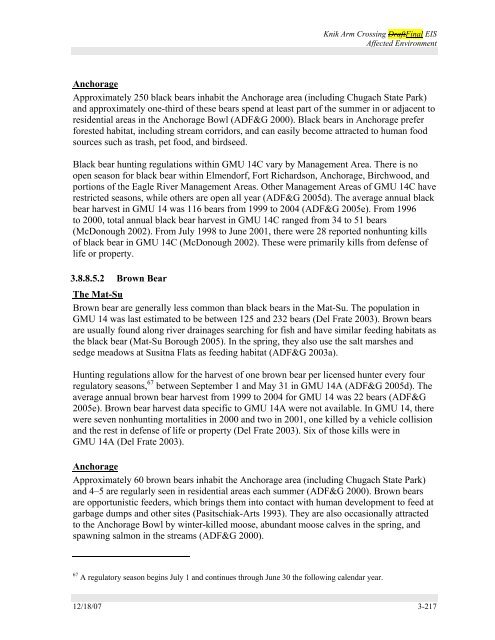3.0 Affected Environment - Knik Arm Bridge and Toll Authority
3.0 Affected Environment - Knik Arm Bridge and Toll Authority
3.0 Affected Environment - Knik Arm Bridge and Toll Authority
You also want an ePaper? Increase the reach of your titles
YUMPU automatically turns print PDFs into web optimized ePapers that Google loves.
<strong>Knik</strong> <strong>Arm</strong> Crossing DraftFinal EIS<br />
<strong>Affected</strong> <strong>Environment</strong><br />
Anchorage<br />
Approximately 250 black bears inhabit the Anchorage area (including Chugach State Park)<br />
<strong>and</strong> approximately one-third of these bears spend at least part of the summer in or adjacent to<br />
residential areas in the Anchorage Bowl (ADF&G 2000). Black bears in Anchorage prefer<br />
forested habitat, including stream corridors, <strong>and</strong> can easily become attracted to human food<br />
sources such as trash, pet food, <strong>and</strong> birdseed.<br />
Black bear hunting regulations within GMU 14C vary by Management Area. There is no<br />
open season for black bear within Elmendorf, Fort Richardson, Anchorage, Birchwood, <strong>and</strong><br />
portions of the Eagle River Management Areas. Other Management Areas of GMU 14C have<br />
restricted seasons, while others are open all year (ADF&G 2005d). The average annual black<br />
bear harvest in GMU 14 was 116 bears from 1999 to 2004 (ADF&G 2005e). From 1996<br />
to 2000, total annual black bear harvest in GMU 14C ranged from 34 to 51 bears<br />
(McDonough 2002). From July 1998 to June 2001, there were 28 reported nonhunting kills<br />
of black bear in GMU 14C (McDonough 2002). These were primarily kills from defense of<br />
life or property.<br />
3.8.8.5.2 Brown Bear<br />
The Mat-Su<br />
Brown bear are generally less common than black bears in the Mat-Su. The population in<br />
GMU 14 was last estimated to be between 125 <strong>and</strong> 232 bears (Del Frate 2003). Brown bears<br />
are usually found along river drainages searching for fish <strong>and</strong> have similar feeding habitats as<br />
the black bear (Mat-Su Borough 2005). In the spring, they also use the salt marshes <strong>and</strong><br />
sedge meadows at Susitna Flats as feeding habitat (ADF&G 2003a).<br />
Hunting regulations allow for the harvest of one brown bear per licensed hunter every four<br />
regulatory seasons, 67 between September 1 <strong>and</strong> May 31 in GMU 14A (ADF&G 2005d). The<br />
average annual brown bear harvest from 1999 to 2004 for GMU 14 was 22 bears (ADF&G<br />
2005e). Brown bear harvest data specific to GMU 14A were not available. In GMU 14, there<br />
were seven nonhunting mortalities in 2000 <strong>and</strong> two in 2001, one killed by a vehicle collision<br />
<strong>and</strong> the rest in defense of life or property (Del Frate 2003). Six of those kills were in<br />
GMU 14A (Del Frate 2003).<br />
Anchorage<br />
Approximately 60 brown bears inhabit the Anchorage area (including Chugach State Park)<br />
<strong>and</strong> 4–5 are regularly seen in residential areas each summer (ADF&G 2000). Brown bears<br />
are opportunistic feeders, which brings them into contact with human development to feed at<br />
garbage dumps <strong>and</strong> other sites (Pasitschiak-Arts 1993). They are also occasionally attracted<br />
to the Anchorage Bowl by winter-killed moose, abundant moose calves in the spring, <strong>and</strong><br />
spawning salmon in the streams (ADF&G 2000).<br />
67 A regulatory season begins July 1 <strong>and</strong> continues through June 30 the following calendar year.<br />
12/18/07 3-217
















